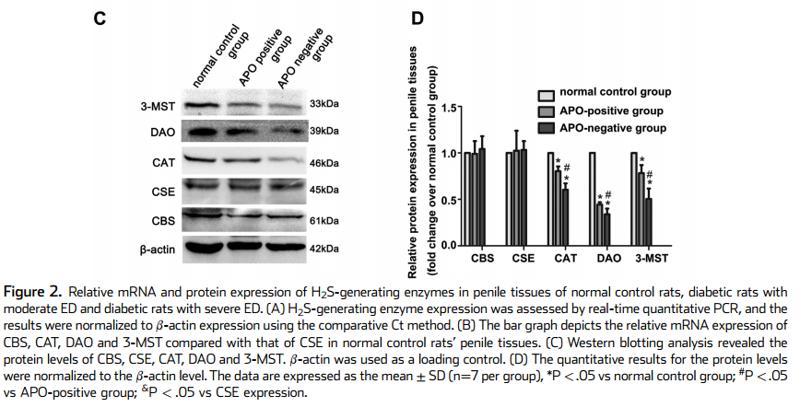DAO Antibody - #DF7266
| Product: | DAO Antibody |
| Catalog: | DF7266 |
| Description: | Rabbit polyclonal antibody to DAO |
| Application: | WB IHC |
| Cited expt.: | WB |
| Reactivity: | Human, Mouse, Rat |
| Prediction: | Pig, Bovine, Horse, Sheep, Rabbit, Dog, Chicken, Xenopus |
| Mol.Wt.: | 39kDa; 39kD(Calculated). |
| Uniprot: | P14920 |
| RRID: | AB_2839205 |
Related Downloads
Protocols
Product Info
*The optimal dilutions should be determined by the end user. For optimal experimental results, antibody reuse is not recommended.
*Tips:
WB: For western blot detection of denatured protein samples. IHC: For immunohistochemical detection of paraffin sections (IHC-p) or frozen sections (IHC-f) of tissue samples. IF/ICC: For immunofluorescence detection of cell samples. ELISA(peptide): For ELISA detection of antigenic peptide.
Cite Format: Affinity Biosciences Cat# DF7266, RRID:AB_2839205.
Fold/Unfold
D-amino-acid oxidase; DAAO; DAMOX; DAO; DAO1; EC 1.4.3.3; MGC35381; OXDA; OXDA_HUMAN;
Immunogens
A synthesized peptide derived from human DAO, corresponding to a region within C-terminal amino acids.
- P14920 OXDA_HUMAN:
- Protein BLAST With
- NCBI/
- ExPASy/
- Uniprot
MRVVVIGAGVIGLSTALCIHERYHSVLQPLDIKVYADRFTPLTTTDVAAGLWQPYLSDPNNPQEADWSQQTFDYLLSHVHSPNAENLGLFLISGYNLFHEAIPDPSWKDTVLGFRKLTPRELDMFPDYGYGWFHTSLILEGKNYLQWLTERLTERGVKFFQRKVESFEEVAREGADVIVNCTGVWAGALQRDPLLQPGRGQIMKVDAPWMKHFILTHDPERGIYNSPYIIPGTQTVTLGGIFQLGNWSELNNIQDHNTIWEGCCRLEPTLKNARIIGERTGFRPVRPQIRLEREQLRTGPSNTEVIHNYGHGGYGLTIHWGCALEAAKLFGRILEEKKLSRMPPSHL
Predictions
Score>80(red) has high confidence and is suggested to be used for WB detection. *The prediction model is mainly based on the alignment of immunogen sequences, the results are for reference only, not as the basis of quality assurance.
High(score>80) Medium(80>score>50) Low(score<50) No confidence
Research Backgrounds
Regulates the level of the neuromodulator D-serine in the brain. Has high activity towards D-DOPA and contributes to dopamine synthesis. Could act as a detoxifying agent which removes D-amino acids accumulated during aging. Acts on a variety of D-amino acids with a preference for those having small hydrophobic side chains followed by those bearing polar, aromatic, and basic groups. Does not act on acidic amino acids.
Peroxisome.
Belongs to the DAMOX/DASOX family.
Research Fields
· Cellular Processes > Transport and catabolism > Peroxisome. (View pathway)
· Metabolism > Amino acid metabolism > Glycine, serine and threonine metabolism.
· Metabolism > Amino acid metabolism > Arginine and proline metabolism.
· Metabolism > Metabolism of other amino acids > D-Arginine and D-ornithine metabolism.
· Metabolism > Global and overview maps > Metabolic pathways.
References
Application: WB Species: Mouse Sample: lungs
Application: IF/ICC Species: Mouse Sample: lungs
Restrictive clause
Affinity Biosciences tests all products strictly. Citations are provided as a resource for additional applications that have not been validated by Affinity Biosciences. Please choose the appropriate format for each application and consult Materials and Methods sections for additional details about the use of any product in these publications.
For Research Use Only.
Not for use in diagnostic or therapeutic procedures. Not for resale. Not for distribution without written consent. Affinity Biosciences will not be held responsible for patent infringement or other violations that may occur with the use of our products. Affinity Biosciences, Affinity Biosciences Logo and all other trademarks are the property of Affinity Biosciences LTD.



